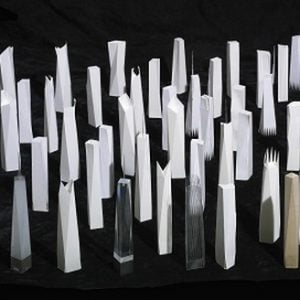
One World Trade Center © Nicola Lyn Evans / WSP | Parsons Brinckerhoff
Ajuda-nos a manter viva e disponível a todos esta biblioteca.

The New Yorker panned the Chrysler Building in 1930 as a publicity stunt with “no significance as serious design.” Architectural Forum dismissed it as an automobile ad in the form of a skyscraper, and The Nation’s reviewer found that it “embodies no compelling, organic idea.”
The Chrysler Building’s reputation improved, of course, but that’s not to say that ambitious buildings are best experienced over time. Ada Louise Huxtable famously called the Kennedy Center in Washington, D.C., “a cross between a concrete candy box and a marble sarcophagus in which the art of architecture lies buried,” and she was not wrong.
The World Trade Center was the subject of intense criticism from the planning stages in the 1960s all the way through the completion of Minoru Yamasaki’s Twin Towers in 1973. The 16-acre project disrupted the city’s historic street grid and did so with aggressively homely buildings — the equivalent of two overgrown Walmart Supercenters stood on their sides — that became icons largely, and perhaps only, because of their outsized scale.
The building that replaced them, David Childs’ new 1,776-foot One World Trade Center, has largely been met with shrugs and notes of missed opportunity. New York Times critic Michael Kimmelman deemed it boring — “symmetrical to a fault, stunted at its peak, its heavy corners the opposite of immaterial” — and disconnected culturally and socially from the rest of Manhattan. Architect Magazine called it “meh.”
What will people say about it in a hundred years?
In her new book One World Trade Center: Biography of the Building and in an interview with Signature, architecture critic and historian Judith Dupré urges an understanding of the building through its numerous contexts as a commercial space, an engineering feat, a part of New York’s skyline, a monument and a political symbol.
SIGNATURE: One World Trade Center’s basic shape is an obelisk made from upward and downward triangles. Is that how you’d describe it?
JUDITH DUPRÈ: It was inspired by the Washington Monument, which is a classic obelisk form. The obelisk was first used to mark land ownerships. The Romans borrowed it from the Egyptians as a commemorative device, which is why the Washington Monument is an obelisk. David Childs, the lead architect on One World Trade Center, had a long career in Washington, D.C., and knew the Washington Monument well. It’s an office tower and a commemorative symbol, and it’s the only building in the world that does that.

When viewed from certain angles, four of One WTC’s planes morph into pyramidal forms. The tower’s tapered silhouette references obelisks and pyramids, two ancient commemorative types. Courtesy Little, Brown and Company / Photo: DBOX
SIG: Who are some of the more recognizable tenants in One World Trade Center?
JD: Condé Nast was an extremely important anchor tenant for the building. Their moving from Times Square to the World Trade Center shifted the focus of the industries in Lower Manhattan, which has traditionally been financial businesses. Condé Nast’s move was a magnet for young, creative media companies that are filling up much of the towers of One World Trade Center. Much of that has to do with subway access to those buildings.
SIG: There’s a subway stop going directly into One World Trade Center, right?
JD: Absolutely. There are 11 subway lines that converge on the World Trade Center. When Condé Nast was considering whether to move there, one of their first questions was how would they get their young, creative employees there who live in New Jersey, Queens, the Bronx and other places around New York City.

Massive steal beam lifted to the top of One WTC © The Port Authority of New York & New Jersey
SIG: The one thing I remember from reading Rem Koolhaas’s Delirious New York years ago was his complaint that monolithic super-blocks like Rockefeller Plaza and Lincoln Center are disruptive to natural change and development of a city. Do you have that concern about the World Trade Center?
JD: I think that Koolhaas is absolutely correct in his tirades against super-blocks. Open access leads to greater livability. The original World Trade Center towers were built on an elevated super-block, and the planners decimated connectivity in Lower Manhattan. Everyone involved in the redevelopment knew that it would be imperative to reopen those streets and to bring the buildings back down to street level. That area is much more accessible now.
SIG: Do you think reopening those streets breaks up the blocks in a way that allows for storefronts and other development to evolve over time?
JD: It does to some extent. The World Trade Center in order to recoup its insurance proceeds had to rebuild in kind. They had to replace 11 million square feet of commercial office space, which is why there are no residential towers at the World Trade Center. If you look at the four buildings that encircle the 9/11 Memorial pools, you’ll see that there is no retail on the sides that face the memorial. That maintains the dignity of the Memorial Plaza. There are stores and restaurants on the other sides of those buildings, and there will be many stores and restaurants in the Transportation Hub.
For security reasons, some of the streets are not open to general traffic, but the sidewalks have increased the walkability and made those streets much more accommodating to pedestrians and cyclists. They have made a new public space in Lower Manhattan that is full of life, a place of democratic assembly.

Dozens of investigatory models broke open the thinking about One WTC’s design © Skidmore, Owings, & Merrill
SIG: Is there a major feature in the engineering and construction of One World Trade Center that you would expect to see in the next generation of buildings?
JD: Absolutely. One World Trade Center is built around an extremely thick concrete core that goes up the center of the building from the bedrock to the roof. All of the building’s vital systems and all of the staircases and elevators are within that concrete core.
SIG: So it’s something like a giant flagpole running through the center of the building?
JD: Right. That’s the biggest technological development in how new skyscrapers will be built. Concrete cores are used widely throughout the world because there are so efficient. The structural engineers for most of the Trade Center towers and the architect wanted to use a concrete core, and it came down to New York City unions. New York had always built steel first and concrete second, and the Twin Towers were basically giant steel cages.
SIG: Which is why they collapsed.
JD: Yes. The engineers and the architects studied that and were determined to do better, and they sat down with the heads of the New York unions and said they had to do better. By every structural and logistic measure, the building is extremely safe. It’s the safest skyscraper in the world. It was designed for all sorts of worst-case scenarios — a plane hitting it, a truck bomb, an earthquake. The concrete core is much more effective at protecting the building against those scenarios than the steel cage. It protects the evacuation routes, fire-fighting access, communications and backup power sources. Those were all lessons learned from 9/11.
SIG: The two knocks on the One World Trade building and the complex in general are that the street plan is very sterile and that the buildings are monolithic and blocky.
JD: All things were not possible. The Port Authority had to build 11 million square feet of commercial office space, and half of the 16 acres were dedicated to the 9/11 Memorial.
SIG: So you would say the complaints that there should have been residential buildings or a Metropolitan Opera-scale performance space or other ideas were never going to happen by the nature of the project?
JD: What had to be replaced was office space and retail. There had to be a memorial. There could be no residential space. The streets had to be opened up. And don’t forget that we were well into the throes of the Bilbao effect. Ever since Frank Gehry’s Guggenheim Museum in Bilbao, Spain, we have been enthralled with flamboyant one-off buildings, and there was already a backlash against that. These buildings had to be timeless. They had to defy trend.
We have an Instagram mentality today that you need to understand something in a nanosecond. If you spend time looking at One World Trade, you will see that it’s color constantly changes. It is a constant reflection of everything around it. Twenty years from now, that building is still going to look great. A lot of signature buildings will not be able to make that claim, and many of them already look dated.

A close-up reflection of One WTC © Nicola Lyn Evans / WSP | Parsons Brinckerhoff
SIG: For me, seeing the Memorial’s waterfalls was a sobering experience. I’m sure a lot of that is relating my own memories of 9/11 to seeing it. Do you think people born since 9/11 will have a different experience thirty or forty years from now?
JD: The Memorial Pools have an archetypal design that will endure. It’s all about the beneficence of water and we the living who stand along the edges and peer down into those center pools and see the water disappear out of sight. It taps into our most primal identity. We understand — consciously or not — that we are part of a long continuum. People came before us, and people will come after us.
SIG: This is a very philosophical question, but are we imposing on generations not yet born the idea that experiencing this space should be a somber thing?
JD: The events won’t have the same immediacy that they have for us who lost friends and family, but they will know that human beings lost their lives. Each of the pools is surrounded by the names of those who died, and each of those names reflects a relationship. What is so powerful at the 9/11 Memorial is that each of the names is placed to a name where there is a relationship. They worked together, or they are family members, or they were strangers who found themselves together at that last moment. A hundred years from now when there is no one alive who remembers 9/11, people will still be able to relate to that.

One WTC spire detail © The Port Authority of New York & New Jersey
O Artigo Is One World Trade Center Good Architecture?, foi publicado em: Signature Reads
The post Is One World Trade Center Good Architecture?, appeared first on: Signature Reads
Assinados por Artes & contextos, são artigos originais de outras publicações e autores, devidamente identificadas e (se existente) link para o artigo original.







